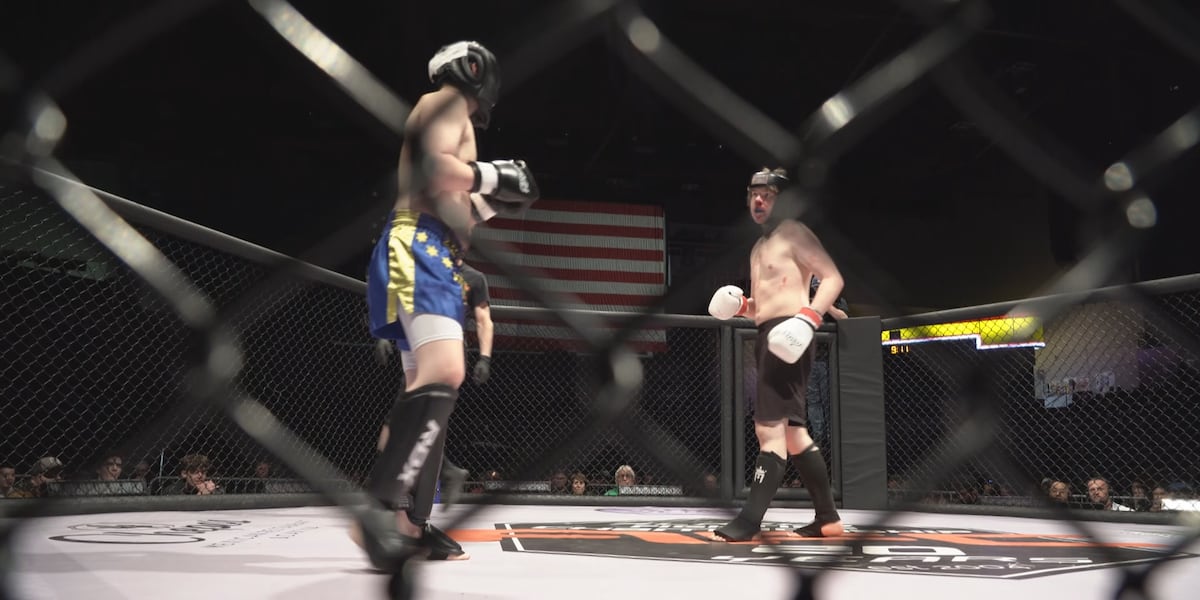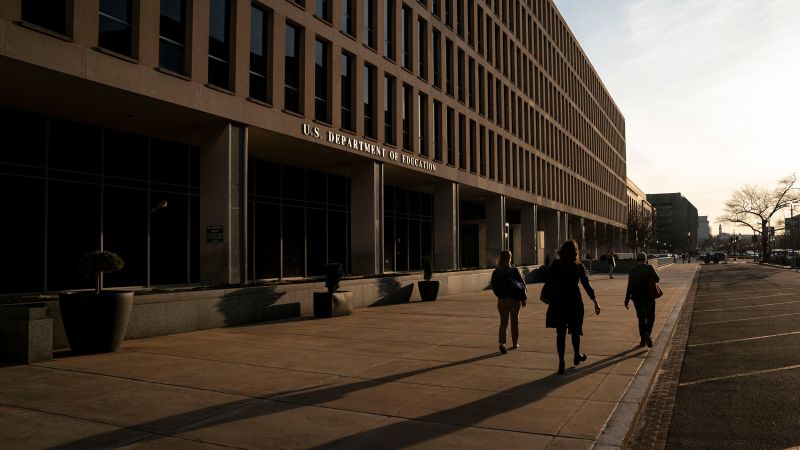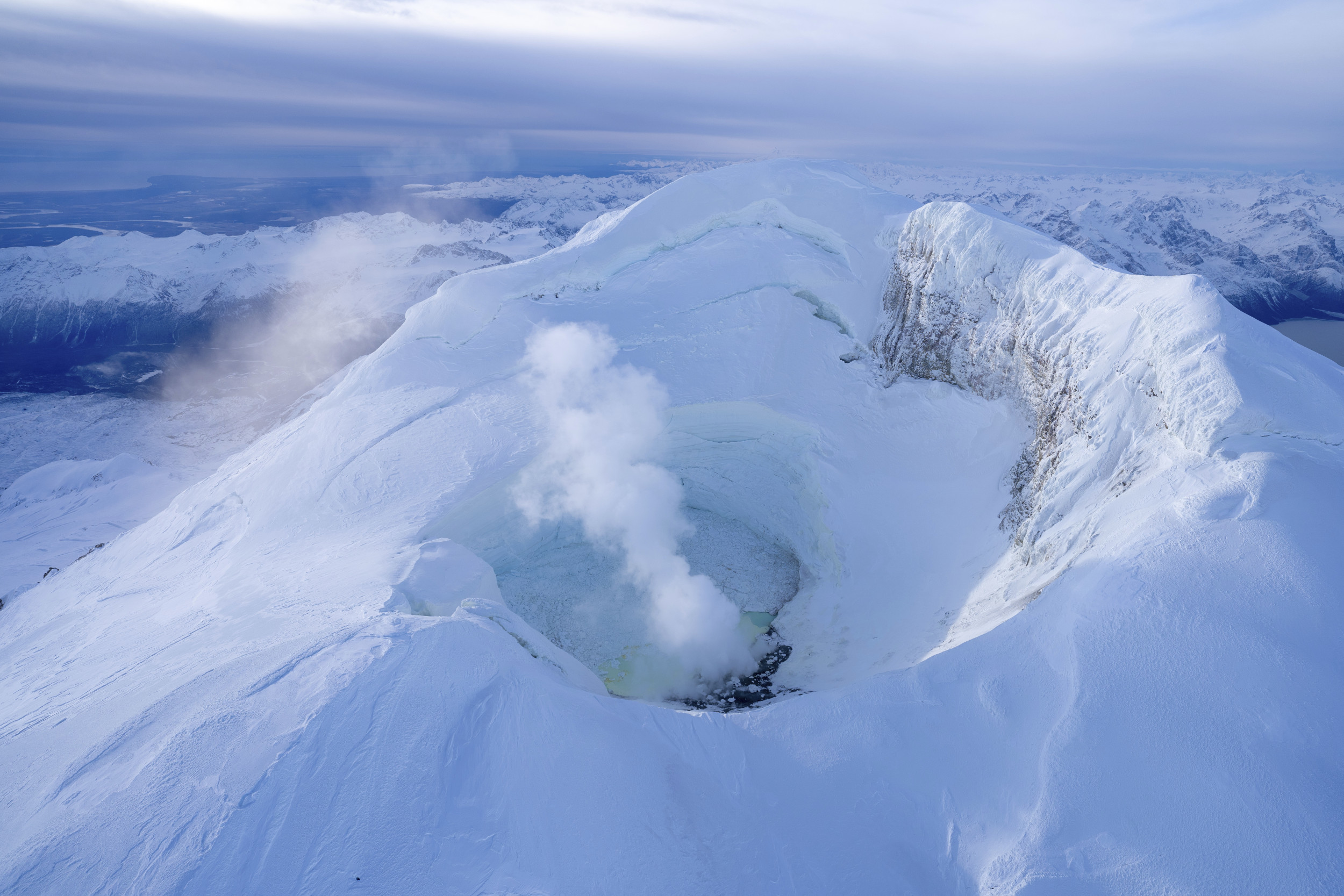Alaska
Chefornak man killed in tribal police officer-involved shooting
/cloudfront-us-east-1.images.arcpublishing.com/gray/7AJY2DYDZZCQJN4S7QNX75D6PI.jpg)
ANCHORAGE, Alaska (KTUU) – A man was shot by a Village of Chefornak tribal police officer just after midnight Saturday and later died at a local clinic, according to a report from the Alaska State Troopers dispatch.
Christopher Wasili, 39, Chefornak, is accused of shooting at tribal police officers with a rifle. A tribal police officer shot Wasili with a personally owned handgun, AST wrote in the report. Wasili died at a local clinic from a gunshot wound at 3:10 a.m. Next of kin have been notified. Wasili’s body was sent to the State Medical Examiner’s Office for an autopsy.
There’s an investigation launched by the Alaska Bureau of Investigation.
Copyright 2023 KTUU. All rights reserved.

Alaska
Opinion: Stop self-sabotaging Alaska’s opportunity of a lifetime
In the halls of the Alaska State Legislature, a recent resolution has sparked debate — not for its substance, but for its intent.
Seemingly a gesture of goodwill toward Canada, it’s actually a deliberate jab at President Donald Trump. This is no grand geopolitical strategy; it’s simply a poke in the eye.
Most legislators have little background or global experience to wade into strategic battles beyond our state’s borders. As someone who has served all over the world in the military and as an airline pilot, including alongside our Canadian comrades in arms, I can say with certainty: Alaskans and Canadians don’t need a resolution to affirm their mutual respect for each other. The only message this resolution sends is one of political shade. It’s a game the Alaska Senate should refuse to play.
This distraction comes at a pivotal moment. President Trump, from day one, has signaled a commitment to unleashing Alaska’s vast energy and resource potential — a stark contrast to the Biden Administration, which issued 70 executive orders stifling our state’s development. Where the Biden Administration treated Alaska like a colonial outpost, Trump sees our oil, gas, timber, minerals and other rich resources as national assets. His reversal of policies that smothered Alaska offers a lifeline to a state looking to stand on its own.
Our private sector is weak. We’ve relied on oil and gas, an industry which helped build Alaska and kept us afloat. However, it is always volatile.
Most of the money for the budget we spend every year comes from the federal government. It’s not free money because most of us pay income taxes.
Alaska gets a lot more money from the federal government than we put into it because we’re so small. We have a small population by size compared to our landmass, which is more than twice the size of the next largest state. We have a lot of far-flung infrastructure to maintain. With so few people, there is no realistic way for us to pay for this without help if we continue to support every corner of Alaska.
When most of our budget flows from Washington, D.C., this binds us to federal whims.
Can we wean ourselves off this dependency? Our population cannot shoulder the costs alone, and the state’s spending often defies fiscal sense.
Here’s an example: Alaska has a population of 740,133 people and includes 54 school districts. Our largest school district has shrinking enrollment, new buildings, while continuously threatening to cut programs and asking for significant increases in funding. The Legislature sets the purse strings, but local districts decide how to spend the money. As a result, we are stuck in a cycle of “just add money” without requiring improved accountability and better performance.
If a school district or borough struggles with funding priorities, that’s on those entities — not the Legislature. In fact, the state has spent so much in recent years that we are hundreds of millions of dollars behind being able to pay the state’s bills this year, and next year is worse. Many of the problems we are facing aren’t from a lack of spending money, even money we don’t have.
An unfortunate “scare” tactic school districts and other government agencies use is a phenomenon called the Washington Monument Syndrome. It’s a form of political extortion whereby an organization faced with budget reductions threatens to cut the most visible or appreciated service in order to spark public outcry. We, the Legislature, have little control over what those districts do beyond providing funding.
The real hope for Alaska lies in reclaiming our land and resources in order to maximize their potential for all — including the public and private sector. With Trump’s backing, we could manage more of our own territory — timber, fish, minerals and energy that’s the envy of most of the world — freeing us from federal dependency.
We all want to protect our pristine lands for future generations, but we also must have sustainable development to fund that future. Projects like these take years, and with oil prices shaky, the next few years may be bumpy. But 6 to 10 years from now, as pipelines, mines, energy projects and more come online, Alaska can boom. Our potential is vast, but it demands leaders who see beyond political stunts to a self-reliant future.
Sen. Mike Shower is a member of the Alaska Senate. He lives in Wasilla.
• • •
The views expressed here are the writer’s and are not necessarily endorsed by the Anchorage Daily News, which welcomes a broad range of viewpoints. To submit a piece for consideration, email commentary(at)adn.com. Send submissions shorter than 200 words to letters@adn.com or click here to submit via any web browser. Read our full guidelines for letters and commentaries here.
Alaska
In the Ring: Alaska Fighting Championship Celebrates 20th Anniversary

ANCHORAGE, Alaska (KTUU) -The Alaska Fighting Championship was held this weekend, marking the 20th anniversary of the sport in the state.
Sullivan Arena was electric as the fighters were introduced one at a time. There were six fights held in total through a variety of mediums. AMMY Muay Thai, MMA, and Bare-Knuckle Boxing were all represented at the professional level.
It was a sight to see as each fighter pushed themselves to the limit to take home the win. The second fight of the night was a Wasilla bout as Tim Watson in the Blue Corner took on Richard Strom the Third in the Red Corner. Both men from Wasilla were looking to take the victory home.
Richard Strom the Third has been competing in the sport for a while now, after being inspired by his brothers when he was young. Strom said the feeling of being in the cage is something else.
“Probably the biggest gentleman rush I’ve ever had in my life. Many, many years of training have come down to this moment,” AFC Fighter Richard Strom said.
In the cage, there isn’t a lot of time to think about your actions, and Strom says he wasn’t worried about the bout.
“I knew I can beat him on the feet no matter what. I’m gonna take no damage. I’m just gonna go in there and just take him out,” Strom said, referring to his plan.
With a victory under his belt Strom is looking to take his talents to the top.
“I see myself in the Octagon, I see myself in the UFC, I see myself a top 10 or top five UFC contender. I see myself training at American top team in Coconut Creek, Florida. That is exactly where I see myself,” Strom said.
See a spelling or grammar error? Report it to web@ktuu.com
Copyright 2025 KTUU. All rights reserved.
Alaska
Burn him down: A history of effigy-burning protests in Alaska

Part of a continuing weekly series on Alaska history by local historian David Reamer. Have a question about Anchorage or Alaska history or an idea for a future article? Go to the form at the bottom of this story.
What do Fairbanks, Alaska, and Tehran, Iran, have in common? Not a riddle but a genuine question. People are people everywhere, driven by similar base needs and desires, so don’t be fooled by the more obvious geographic and cultural divides. There’s more than one similarity. Still, a particular detail stands out. Effigies of President Jimmy Carter were burned in both towns, nearly twin moments separated by continents.
There is a long history of strident political protest in Alaska from all points along the political spectrum. Liberal protests. Conservative protests. Serious protests. Silly protests. Protests in all shapes and forms. In 1911, residents at Cordova shoveled a shipment of coal into the harbor to protest land conservation efforts that forced Alaskans to import coal rather than mine it here. It was a Cordova Coal Party. For a different tone entirely, what is now the University of Alaska Fairbanks banned alcohol on campus in 1957. Students predictably disliked the new policy and dug a grave, which was filled with beer bottles and topped with a concrete headstone with a metal plate that read: “Here Lies Tradition, 1957.” Or, who remembers the Annoy Prevo: Think For Yourself bumper stickers of early 1990s Anchorage lore, referring to Baptist minister Jerry Prevo?
Like the Cordova Coal Party, some of these protests coalesced into genuine cultural moments that are crucial to understanding the flow of Alaska history, events such as the 1961 Barrow Duck-In and the 1979 Denali Trespass. For all that, there is something more pointedly personal about burning an effigy. More than a stand against a policy or platform, effigy burnings seek to destroy the person, symbolically at the least, wish fulfillment at the most. And Alaska history is likewise generously dotted with a series of effigy burnings. The following is a review of some but not all effigy-related protests in Alaska history, the most important, memorable and ridiculous.
Burning effigies as a form of protest is an ancient practice. The leap in logic from having an enemy to destroying them by figural proxy is short. History abounds with examples. From 1328 to 1329, the Holy Roman Emperor Louis IV, usually via his puppet Antipope Nicholas V, burned several effigies of Pope John XXII, after those effigies had been tried and condemned naturally. In 1919, a group of women suffragists lit a 2-foot-tall straw and paper effigy of President Woodrow Wilson on fire in front of the White House. Wilson had been slow in support of the female vote. Nicholas V eventually submitted to Pope John XXII and spent the remainder of his life as a less-than-willing guest within the papal palace. The protesting suffragists were immediately arrested, although Wilson did reluctantly call a special session where the eventual 19th Amendment was passed.
Moreover, a burning effigy is typically a display of citizen power. They are a fundamentally public act; try one inside your home if you think otherwise. The American history of effigy burning predates the Revolutionary War. In late 1765, several English newspapers published a letter from Boston. The author reported, “two effigies, one of which by the labels appeared to be designed to represent a Stamp Officer, the other a Jackboot with a head and horns peeping out of the top.” These effigies were hung from a tree, then paraded through town and burned atop a hill.
The horned “Jackboot” referred to John Stuart, 3rd Earl of Bute, the British Prime Minister from 1762 to 1763 and even thereafter a close adviser to King George III. American colonists reviled Stuart for his preferred policy of heavily taxing the colonies. This included the 1765 Stamp Act that required all Americans to pay taxes on printed paper, including playing cards. The Act prompted the “taxation without representation” line and was a significant catalyst for the revolution that began 10 years later. Stamp officers collected the taxes — in British, not colonial currency, mind you — and were thus obvious targets of abuse and effigy practice.
In the spring of 1910, U.S. Marshal Daniel Sutherland and U.S. District Attorney John Boyce were dismissed from their Alaska posts in favor of men known as stooges for the Morgan-Guggenheim Alaska Syndicate, which sought to monopolize the territory’s transportation, mining and fishing industries. James Wickersham, Alaska’s non-voting Congressional representative, accused Gov. Walter Clark of also being in league with the Syndicate. Like many other Alaskans, Wickersham believed that Clark influenced the removals of Sutherland and Boyce. On April 26, Clark was burned in effigy at Juneau. He publicly laughed off the demonstration in the way that only a highly connected, protected man can. The governor, replacement district attorney and replacement marshal remained in their posts.
Gifford Pinchot was a close confidant of President Theodore Roosevelt. They shared a commitment to the protection of public lands, and Roosevelt accordingly appointed Pinchot as the first Forest Service chief, a position he held from 1905 to 1910. As regards Alaska, Pinchot influenced policies that sought to block the rapacious Alaska Syndicate from exploiting natural resources in the territory. To be clear, his intent was more conservation than preservation, in that he favored responsible and rational resource extraction. However, such attempts to curb more ruthless exploitation did hinder smaller-scale settler development.

Pinchot was therefore widely hated by settler Alaskans. His name was in the mind of every Cordova Coal Party participant. Still, such animosity was far from universal. Juneau of this era was less dependent upon new mining developments than a place like Cordova, which goes to why Gov. Clark was burned in effigy for supporting the same Syndicate opposed by Pinchot.
Katalla, southeast of Cordova, is a ghost town now. It was once a bustling boomtown boasting a few thousand residents but was in swift decline by 1910. The town relied upon the passage of oil and coal for its existence. Blocked development on nearby coal fields meant its demise, and to a person, the residents hated Pinchot. On May 3, 1911, an effigy of Pinchot was burned on the beach there.
By then, Pinchot was not even in office. President William Howard Taft dismissed him in January 1910, a key moment of what became known as the Ballinger-Pinchot Affair. In a very long story made short, Pinchot publicized efforts by Secretary of the Interior Richard Ballinger to subvert conservation efforts in favor of a company that was part of the greater Alaska Syndicate, including with lands in Alaska. Ballinger resigned in 1911, coincidentally working with the same corporate interests. The Taft administration’s efforts to cover up the scandal split the Republican Party and aided the Democrat Woodrow Wilson’s win in the 1912 presidential election.
A more curious incident happened in 1912 Kennecott. Per the Cordova Daily Times, “Some of the Chitina people now believe that in officialdom there a nest of foreigners lord it over Americans.” That March, residents burned an effigy of U.S. Commissioner M.R. Healy, who they believed was not an American citizen. In that, they were right. Healy was Canadian. He admitted to previous lies and was subsequently naturalized but resigned his position.
While most effigies are personal in nature, some represented a broader warning. In May 1912, some miners in the Fairbanks region hung an effigy as a warning for any possible firebugs. It had been a dry spring, and several cabins had burned due to careless fires.
In 1911, the Washington-Alaska Bank of Fairbanks failed and closed its doors with a $1 million in local deposits on its books. Later that year, depositors received half of their money, which comprised the entirety of the recovery for most locals. Blame fell almost entirely upon E.T. Barnette, the bank’s president until just three months prior. Fairbanks as a town originated with Barnette’s trading post on the Chena River, located where he was forced to disembark from a riverboat that could proceed no farther upstream.
Barnette aspired to be a pillar of the new community and briefly swam at the upper echelons of frontier society. Against this desire, he had a habit of cutting corners, of stealing from partners, and for disappearing when needed the most. He was a schemer, and his reputation eventually reached the Earth like the inevitable path of a thrown baseball, once clean and white but destined for the dirt. When the bank failed, Barnette was living in Los Angeles, with greater interest in his Mexican plantation than anything happening in Fairbanks.
The declining local economy — the bloom was well gone from their gold rush heyday a few years prior — played a role in the bank’s decline. However, Barnette’s management was the most significant factor. For example, he used the bank to liquidate himself of company stock at inflated prices, with the institution hiding the ramifications of the stocks’ declining value until years later. While in town, Barnette was incentivized to prop the bank up, to maintain its operation. He personally guaranteed any overdrafts of the bank’s holdings. Once he left in the fall of 1910, he made sure to take all of his own deposits with him.
An embezzlement charge went to trial in December 1912. To the great shock of all observers, Barnette was found not guilty of all major charges and only fined $1,000, a small percentage of the fortune he left town with two years before. Fairbanks Daily News-Miner editor W.F. Thompson described the ruling as “the rottenest judicial farce the North has ever witnessed.”
A few days later, a mysterious advertisement was pasted around Fairbanks. “All Fairbanks invited to attend open air New Year celebration. Monday evening, Jan. 6 at 8 o’clock. Everybody come to the waterfront.” Not having anything better to do on a January evening in the time before radio, TV, or internet, much of the town turned out for the show. A group of women with lost deposits in the Washington-Alaska Bank constructed three effigies. Two of them depicted John Clark and John McGinn, Barnette’s lawyers. The last effigy was of Justice, seemingly abandoned in Alaska. After a lengthy expository prayer, the effigies were burned with cheers heard for several blocks. Pictures of the event were subsequently exhibited at the theater.
The Alaska Railroad Act, which authorized and guaranteed funding for the construction of that railroad passed in March 1914. For many in Alaska and Washington, D.C., a government-owned railroad was a way to circumvent corporate interests like the aforementioned Alaska Syndicate and yet promote more independent development in Alaska. In theory, such a railroad would balance conservation and settler self-determination. Yet, a few Alaskans disliked the concept.
On April 13, 1913, seven senators of the Alaska Territorial Legislature submitted a letter to Secretary of the Interior Franklin Lane. The legislators agreed that a railroad in Alaska was “an imperative necessity to the development of our vast mineral resources.” Instead, they argued, “The majority of people, in our opinion, are opposed to the principle of government ownership.”
Despite the veneer of authority, the letter was not an official missive from the Territorial Legislature. Furthermore, the letter certainly reflected a minority opinion within the Legislature. In a speech to the House of Representatives, James Wickersham noted, “Out of 24 members of the legislature, seven of them have sought to prevent the passage of the Alaska railway bill by sending this communication to Washington to be used in debate, at the moment when it would do the Territory of Alaska the greatest amount of harm, by the opponents of the bill.”
The existence of the letter did not become public knowledge until early 1914 when it was weaponized by opponents of the railroad bill. The Alaska public response suggests the seven men had not misjudged the support for a government railroad so much as willfully misrepresented its nature. Indeed, in Alaska, those same men had acted more neutrally toward the idea of a government-owned railroad. The Territorial Senate had notably declined to take a public stand on either side of the railroad bill.
The public response to the letter was heated. In Cordova, pioneer resident George Dooley led a group that hung seven effigies on a line across the town’s main thoroughfare, one for each signatory to that letter. A sign on them declared: “The Traitors to Alaska.” They swung in the breeze for a while before they were taken down and burned. The implied threat was possibly not an empty one. The Petersburg Herald suggested, “the rebuke administered to the traitors by the Cordovans was much too mild for the offence. Fortunately, the end is not yet.” A bit ominous, that.
The next day, the Cordova Daily Alaskan made an observation that ties this era of effigy burnings together. Their editor opined, “Pinchotism’s blight on Alaska has forever been removed.” Four years after Taft dismissed Pinchot, Alaskans still frequently blamed the former Forest Service chief for lack of development in the territory.
Truly, the early 1910s were the heyday of effigy burning in Alaska. Alaskans hated the government, even the presence of the government, but at the same time had high expectations for government performance and expected the government to make their lives better. It was an uneasy, contradictory perspective on the world in a rapidly changing time. Firestarters abounded, as apparently did experts in life-size doll making.
The practice of burning effigies thereafter dwindled in popularity and severity, excepting that of President Carter. In 1934, Fairbanks hosted its first Ice Carnival, which inspired the creation of the Fur Rendezvous two years later. On the event’s last day, March 11, an effigy of “Old Man Depression” was burned on the banks of the Chena River. Old Man Depression was a personalization of the Great Depression, burned as a symbolic attempt to free themselves from what seemed like an eternal economic despair. This was far from an original act. Old Man Depression effigies had been buried, burned, and hung in towns across the country since 1930 and for several years after that Ice Carnival.
In March 1961, a 17-year-old student at Anchorage’s West High School hung an effigy of Principal Leslie Wells near the school. Wells was, of course, demonstrably guilty of keeping kids from doing all manner of cool things. Again, some effigies and some protests are more serious than others. Further indignities, including fire, were likely planned for the effigy, but the ringleader and his accomplices were quickly apprehended. Per the contemporary coverage, “A policeman patrolling the area nabbed the perpetrators and gave them 20 minutes to remove the ‘dummy.‘” No charges were filed, which is a constant with effigy protests in Alaska.
One month later, in April 1961, Gov. Bill Egan proposed a sweeping measure that would raise taxes on everything from alcohol to income. Many of these marked dramatic increases, as with a 60% higher cigarette tax. George Allen of Chugiak, an Alaska Democratic Party district vice chairman, suggested Egan be burned in effigy, even promised a local meeting on the idea. Notably, Egan was also a Democrat. There was a vote, and effigy burning lost in favor of a recall campaign that was in turn eventually abandoned.

The recently passed Jimmy Carter was the modern equivalent of Gifford Pinchot, as regards that specific intersection of land conservation, preservation, development, and rabid Alaskans. On Dec. 1, 1978, President Carter invoked the 1906 Antiquities Act and created 15 national monuments in Alaska and enlarged two others, withdrawing 56 million acres from possible resource development. The withdrawals were part of the long aftermath of the 1971 Alaska Native Claims Settlement Act and a bridge over congressional gridlock until the passage of the 1980 Alaska National Interest Lands Conservation Act.
Like the residents of Katalla and Cordova decades earlier, broad swaths of Alaskans were incensed at Carter and Interior Secretary Cecil Andrus for blocking development and, as they saw it, denying Alaskan self-determination. Groups of picketing protesters became a common scene in Anchorage, Fairbanks, and several other Alaska towns. Some of the signs pictured Carter hanging in a noose. In Ketchikan, two life-sized straw effigies of Carter and Andrus were tossed into the water. Organizer Ted Clifton declared, “We’re going to drown them here.”
Over the next several months, park rangers were repeatedly insulted and openly threatened across the state. A movement emerged in Eagle to expel any National Park Service, or NPS, presence from town. As a 1979 resolution declared, “The city council of Eagle Alaska does not advocate violence, but we can be no more responsible for the actions of an individual citizen than we can be for any animal when it is cornered.” An arsonist torched an NPS Cessna at Tazlina. In Glennallen, a business hung signs declaring, “We reserve the right to refuse service to anyone. Park Service personnel not welcome.”
In January 1979, a mass protest occurred at what is now Denali National Park. Known as the Denali Trespass, a few thousand Alaskans gathered with the stated intent to break every possible rule, regulation, and law. They drank every intoxicant in sight, hunted when they weren’t indiscriminately firing guns, built bonfires, and drove snowmachines everywhere. Some conducted target practice on images of King George III with a “Carter?” inscription. They dared any official to arrest them, but park rangers simply observed from a distance. One intoxicated demonstrator died when he drove his snowmachine onto a landing strip and into an airplane.
And there was that effigy burning, that link between Fairbanks and Tehran. Carter was burned in effigy on December 11, 1978, a planned event conducted at the downtown Fairbanks post office. An advertisement for the protest ran in the News-Miner, placed by the “Interior Wildlife Association,” and depicted Carter with an Adolf Hitler-style mustache. Then Fairbanks Mayor William Wood attended and participated, as did past mayors Harold Gilliam and Paul Haggland.

When Jimmy Carter died at the end of 2024, most Alaska commentators adopted a soft approach toward the former president, and understandably so. But the antipathy toward Carter in late 1970s Alaska was real, a vicious and bitter movement. It was far more malevolent than dunk tanks at the state fair with his pictures of his face, something that also happened.
Some historians have claimed there was no unanimous late 1970s Alaska hostility to Carter and land conservation. While technically true, the opposition to Carter from late 1978 through the end of his presidency was overwhelming in effect. Per a July 1979 poll, only 16% of Alaskans approved of Carter’s actions. By that same poll, only 10% of Alaskans favored him for reelection. And at that next election, Carter pulled only 26% of the Alaskan electorate, almost 10 percentage points worse than his performance in 1976 and the worst performance by a Democratic presidential candidate in Alaska history.
Perhaps the most amusing effigy burning incident in Alaska involved a fast-food clown. In 1989, the announcement of a new McDonald’s location in Fairbanks sparked anger among area residents. Zena Toy burned two Ronald McDonald effigies on her lawn and hung a third during the construction. She told the News-Miner, “There’s going to be giant golden arches and stinky hamburger smell and tons of Styro on Geist Road.” Bob Morton lived two blocks away from Toy and supported the new franchise, the fourth in Fairbanks. He said, “I think it’s great. And I thought her Ronald McDonald was cute, but dumb.” The franchise owners did build a wall separating the restaurant from its residential neighbors.
In the spring of 1992, the House Finance Committee passed a budget proposal with significant funding cuts for the University of Alaska, including $1.4 million from UAF’s operating budget. Gov. Wally Hickel’s capital budget included nothing for UAF’s long-deferred maintenance. At the same time, UA system administrators were considering a steep increase in tuition costs. Meanwhile, UAF students went to class and watched the buildings fall apart. Burst radiators and crumbling ceiling tiles were a common sight.
On April 15, around 400 students protested on campus, organized by SWARM, the Student Walkout and Resistance Movement. There were signs like “GIVE US OUR MONEY,” “STOP HICKEL’S RAPE OF UAF,” and “UAF NEEDS A FUTURE.” Eight mostly naked women streaked through the crowd shouting over and over, “We got stripped by Wally Hickel!” An effigy of Hickel was burned to great cheers. That night, about 100 students occupied the Butrovich Building for a peaceful sleep-in. The mere existence of the Butrovich Building, built to house administration offices, angered many students given the proliferation of asbestos and leaky roofs in dorms and classrooms.
The student protest galvanized students toward distinct goals and defined a coherent community. Yet, they were also less successful in reaching those goals. After long ignoring student demands for a meeting, Hickel finally agreed to a teleconference, though the budget cuts continued. Nine days after the protest, the UA Board of Regents passed an unaltered tuition hike.
The historical precedent and Alaskan preference are clear. Over and over, for more than a century, protests in Alaska have been plentiful and varied, sharp and even aggressive in approach. For decades, it has been a credit to our society and government that such protests are both familiar and allowed. For sure, the ways in which a government treats protesters is a barometer of freedom. Read the measurements however you want.
-

 Movie Reviews1 week ago
Movie Reviews1 week agoFilm Review: Rachel Zegler is the Best Part of an Otherwise Dull Remake of ‘Snow White’ – Awards Radar
-

 Education1 week ago
Education1 week agoICE Tells a Cornell Student Activist to Turn Himself In
-

 Politics1 week ago
Politics1 week agoEXCLUSIVE: Groundbreaking new prayer book designed for demographic most targeted for abortion
-

 News1 week ago
News1 week agoShooting at Park in New Mexico Leaves at At Least 3 Dead and 16 Injured
-

 News6 days ago
News6 days agoTrump Is Trying to Gain More Power Over Elections. Is His Effort Legal?
-

 News7 days ago
News7 days agoWashington Bends to RFK Jr.’s ‘MAHA’ Agenda on Measles, Baby Formula and French Fries
-

 News1 week ago
News1 week agoDismantling the Department of Education will strip resources from disabled children, parents and advocates say | CNN
-

 News1 week ago
News1 week agoLeft-Wing Democrats Wait on AOC’s Decision as They Look to 2028 Election




















